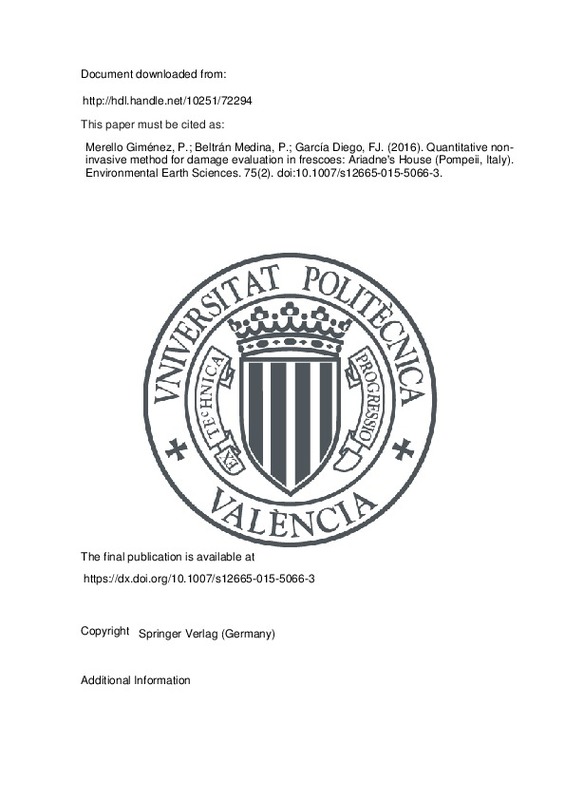Arnold A, Zehnder K (1996) Monitoring wall paintings affected by soluble salts. In: Cather S (ed) The conservation of wall paintings, 2nd edn. Courtauld Institute of Art and the Getty Conservation Institute, London, pp 103–136
Goudie AS, Viles HA (1997) Salt weathering hazards. Wiley, London
Guarneri M, Danielis A, Francucci M, De Collibus MF, Fornetti G, Mencattini A (2014) 3D remote colorimetry and watershed segmentation techniques for fresco and artwork decay monitoring and preservation. J Archaeol Sci 46(1):182–190. doi: 10.1016/j.jas.2014.02.020
[+]
Arnold A, Zehnder K (1996) Monitoring wall paintings affected by soluble salts. In: Cather S (ed) The conservation of wall paintings, 2nd edn. Courtauld Institute of Art and the Getty Conservation Institute, London, pp 103–136
Goudie AS, Viles HA (1997) Salt weathering hazards. Wiley, London
Guarneri M, Danielis A, Francucci M, De Collibus MF, Fornetti G, Mencattini A (2014) 3D remote colorimetry and watershed segmentation techniques for fresco and artwork decay monitoring and preservation. J Archaeol Sci 46(1):182–190. doi: 10.1016/j.jas.2014.02.020
Hamamcioglu-Turan M, Akbaylar I (2011) Documentation of historic structures for the assessment of heritage characteristics. J Archit Plan Res 28(2):129
Merello P, García-Diego FJ, Zarzo M (2012) Microclimate monitoring of Ariadne’s House (Pompeii, Italy) for preventive conservation of fresco paintings. Chem Cent J 6:145. doi: 10.1186/1752-153X-6-145
Merello P, García-Diego FJ, Zarzo M (2013) Evaluation of corrective measures implemented for the preventive conservation of fresco paintings in Ariadne’s House (Pompeii, Italy). Chem Cent J 7(1):87. doi: 10.1186/1752-153X-7-87
Myra J, Giesena A, Ungb P, Warkec A, Christgenb B, Mazela AD, Grahamb DW (2014) Condition assessment and preservation of open-air rock art panels during environmental change. J Cult Herit 15:49–56. doi: 10.1016/j.culher.2013.01.013
Nevin A, Melia JL, Osticioli I, Gautier G, Colombini MP (2008) The identification of copper oxalates in a 16th century Cypriot exterior wall painting using micro FTIR, micro Raman spectroscopy and Gas Chromatography-Mass Spectrometry. J Cult Herit. 9:154–161. doi: 10.1016/j.culher.2007.10.002
O’Brien P (1990) An experimental study of the effects of salt erosion on pottery. J Archaeol Sci 17(4):393–401. doi: 10.1016/0305-4403(90)90004-O
Pérez MC, Garcia-Diego FJ, Merello P, D’Antoni P, Fernández Navajas A, Ribera i Lacomba A, Ferrazza L, Pérez-Miralles J, Baró JL, Merce P, D’Antoni H, Curiel J (2013) Ariadne´s house (Pompeii, Italy) wall paintings: a multidisciplinary study of its present state focused on a future restoration and preventive conservation. Mater Construcc 63(311):449–467. doi: 10.3989/mc.2012.00812
Pesando F (1997) Domus: edilizia privata e società pompeiana fra III e I secolo a.C., “L’Erma” di Bretschneider, Rome
Pesando F (2007) La Casa de Ariadna de Pompeya: redescubrimiento de una domus. In: Ribera A, Olcina M, Ballester C (eds) Pompeya bajo Pompeya, Las excavaciones en la Casa de Ariadna. Museo Arqueológico Provincial de Alicante (MARQ), Valencia, pp 21–23
Rodriguez-Navarro C, Doehne E (1999) Salt weathering: influence of evaporation rate, supersaturation and crystallization pattern. Earth Surf Process Landf 24:191–209. doi: 10.1002/(SICI)1096-9837(199903)24:3<191:AID-ESP942>3.0.CO;2-G
Ruiz-agudo E, Lubelli B, Sawdy A, Van Hees R, Price C, Rodriguez-Navarro C (2011) An integrated methodology for salt damage assessment and remediation: the case of San Jerónimo Monastery (Granada, Spain). Environ Earth Sci 63(7):1475–1486. doi: 10.1007/s12665-010-0661-9
Statgraphics Software 5.1. Available online. http://www.statgraphics.net/ . Accessed 18 March 2015
Warke PA, Curran JM, Turkington AV, Smith BJ (2003) Condition assessment for building stone conservation: a staging system approach. Build Environ 38:1113–1123. doi: 10.1016/S0360-1323(03)00085-4
Weritz F, Kruschwitz S, Maierhofer C, Wendrich A (2009) Assessment of moisture and salt contents in brick masonry with microwave transmission, spectral-induced polarization, and laser-induced breakdown spectroscopy. Int J Archit Herit 3(2):126–144. doi: 10.1080/15583050802278992
Winkler EM (1994) Stone in architecture. Springer, Berlin Heidelberg
Wüst R, Schlüchter C (2000) The origin of soluble salts in rocks of the Thebes mountains, Egypt: the damage potential to ancient Egyptian wall art. J Archaeol Sci 27(12):1161–1172. doi: 10.1006/jasc.1999.0550
[-]







![[Cerrado]](/themes/UPV/images/candado.png)


